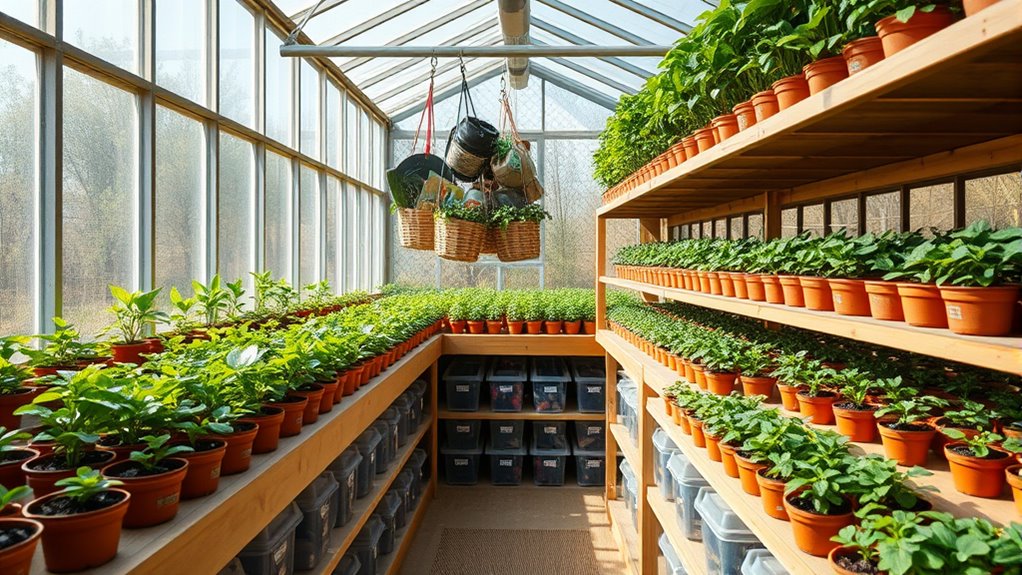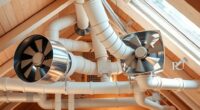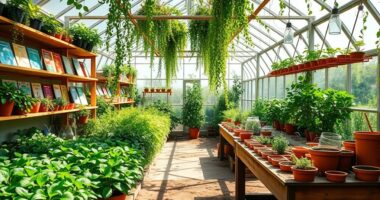To stay organized in your greenhouse, designate specific storage areas for tools, soil, and supplies, using labeled bins, sturdy shelves, and wall-mounted racks. Keep small items in clear containers for quick access and hang tools or hooks to save space. Regular cleaning and routine inspections help catch pest issues early and maintain soil health. Investing in smart storage solutions will make your space more efficient and inviting—if you want to discover more tips, keep exploring!
Key Takeaways
- Designate specific storage areas with labeled bins, shelves, and pegboards for easy access and organization.
- Regularly clean and sanitize storage spaces to prevent pest hiding spots and maintain hygiene.
- Store soil, fertilizers, and amendments in clearly labeled containers and designate separate zones for soil mixing.
- Implement routine maintenance schedules for cleaning, pest inspections, and tool organization to ensure a tidy workspace.
- Use vertical and wall-mounted storage solutions to maximize space and keep frequently used items within reach.

Keeping your greenhouse organized is essential for maintaining a productive and efficient space. When everything has its place, you can focus more on growing healthy plants and less on searching for tools or supplies. A well-organized greenhouse also helps prevent pests and diseases by making it easier to spot issues early. To achieve this, start by establishing designated storage areas for different items. Use sturdy shelves, wall-mounted racks, and labeled containers to keep everything tidy. For tools, consider hanging hooks or pegboards so they’re easily accessible and don’t clutter work surfaces. Keep small supplies like seeds, fertilizers, and pesticides in clearly labeled bins for quick retrieval.
One of the keys to a successful greenhouse is managing pest control methods effectively. By organizing your space, you can reduce pest hiding spots and make treatments more straightforward. Regularly clean and sanitize your shelves and containers to prevent pest buildup. Store pest control supplies separately from your plants to avoid cross-contamination, and keep an inventory of what you have so you don’t forget to restock essential items. When you’re organized, it’s easier to implement preventative pest control methods, like applying neem oil or introducing beneficial insects, because you can find everything you need without delay. Additionally, understanding the importance of shelf stability can help prevent accidents and keep your tools organized.
Soil improvement techniques are also easier to manage when your greenhouse is tidy. Keep your soil amendments, compost, and fertilizers in dedicated, labeled containers, so you know exactly what’s available and how old they are. Proper organization allows you to rotate your soil amendments efficiently, ensuring your plants get the necessary nutrients without waste or confusion. You can also designate specific areas for potting and mixing soil, preventing cross-contamination and maintaining cleanliness. Regularly checking and replenishing your soil improves plant health and reduces the risk of disease, which is easier when your workspace is kept in order.
Finally, take time to create a maintenance schedule that includes routine cleaning, pest inspections, and soil assessments. When you keep your workspace organized, it becomes easier to stick to this schedule and spot issues early. Invest in storage solutions that suit your space and workflow, and always keep tools and supplies stored neatly after each use. This discipline minimizes clutter and creates a more inviting environment for your plants. Overall, staying organized in your greenhouse isn’t just about neatness; it directly impacts pest management, soil health, and your overall success as a grower.
Frequently Asked Questions
How Often Should Greenhouse Storage Areas Be Cleaned?
You should clean your greenhouse storage areas regularly to maintain a healthy environment. Establish a cleaning schedule that fits your greenhouse’s needs, ideally every few weeks or monthly, depending on usage. Consistent storage maintenance prevents pests, mold, and debris buildup. By sticking to this routine, you guarantee your plants stay healthy and your workspace remains efficient. Regular cleaning keeps everything organized, safe, and ready for planting season.
What Are Eco-Friendly Storage Solutions for Greenhouses?
You’re likely seeking eco-friendly storage solutions that align with your green values. Consider using recycled shelving, which repurposes old materials into functional storage, and compostable containers, perfect for reducing waste. These options help you maintain an organized greenhouse while caring for the environment. Embracing such sustainable choices not only keeps your space tidy but also supports eco-conscious gardening, making your greenhouse a true haven for plant life and nature.
How to Prevent Pests in Storage Areas?
To prevent pests in storage areas, you should use pest-resistant containers to keep pests out of your supplies. Regularly inspect and clean storage spaces to remove food debris and hiding spots. Incorporate natural repellents like neem oil or garlic spray around storage zones to deter pests. Guarantee good ventilation and avoid moisture buildup, as pests thrive in humid environments. These steps help keep your greenhouse storage pest-free and organized.
Best Practices for Organizing Seed Trays and Pots?
To organize seed trays and pots effectively, label your seedlings clearly with waterproof seedling labels to avoid confusion. Use pot stacking to save space, but make certain pots are stable and accessible. Keep trays and pots grouped by plant type or growth stage for easy maintenance. Regularly tidy your storage area, and consider using shelving units to keep everything off the ground, making your greenhouse more efficient and easier to manage.
How to Maximize Space in Small Greenhouses?
To maximize space in your small greenhouse, you should use vertical shelving to take advantage of vertical space and keep your plants organized. Incorporate modular storage units that can be easily adjusted or expanded as needed. This approach helps you utilize every inch efficiently, giving you more room for your plants while keeping everything accessible and tidy. Keep pathways clear and optimize your layout for better airflow and growth.
Conclusion
Just like a well-tended garden, a tidy greenhouse blooms with ease and beauty. By keeping your tools and supplies organized, you create a harmonious space where growth thrives. Think of it as tending to a secret garden—each item in its place, ready to support your green thumb. With a little effort now, you’ll enjoy a vibrant, clutter-free haven that nurtures your plants and your passion alike. Keep it organized, and watch your greenhouse flourish.









